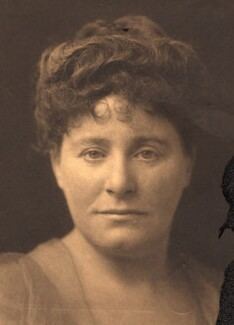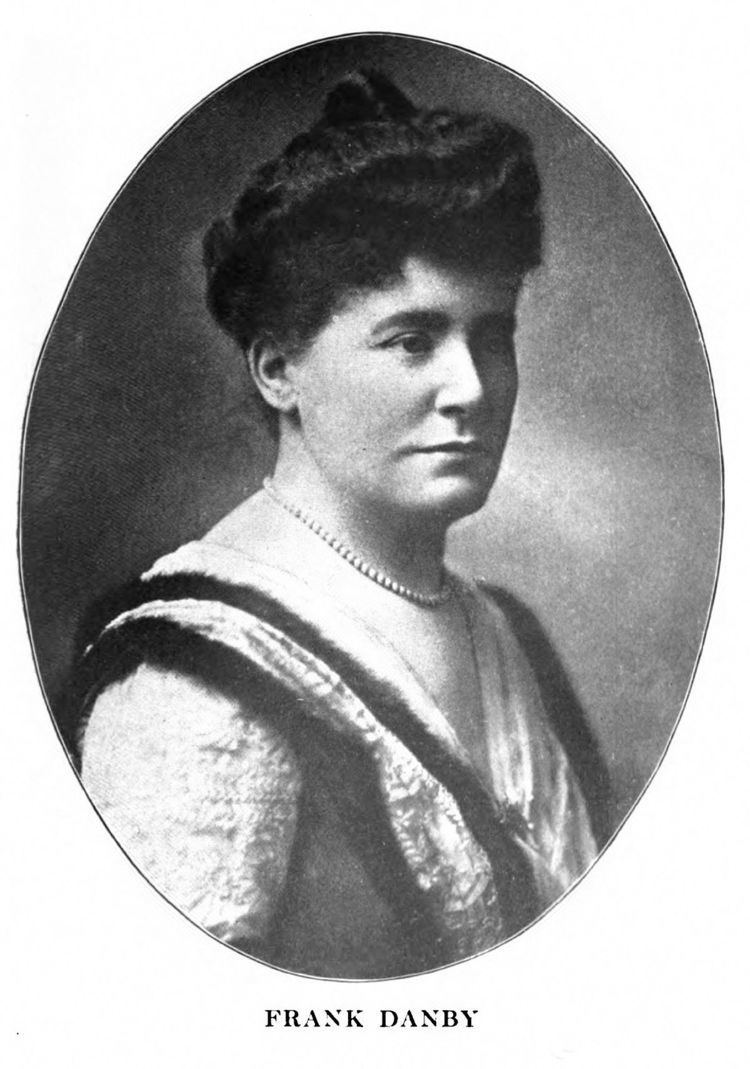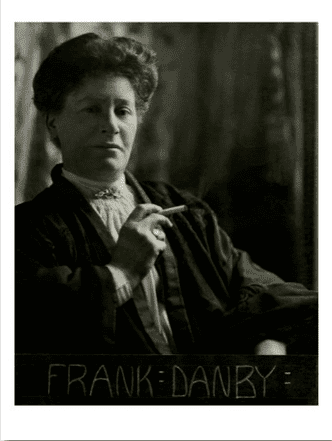Pen name Frank Danby Subject Jewish life in London Occupation Writer Name Julia Frankau | Nationality British Role Novelist Genre Novels Parents Hyman Davis | |
 | ||
Died March 17, 1916, London, United Kingdom Children Gilbert Frankau, Ronald Frankau, Jack Frankau, Joan Bennett Books Joseph in Jeopardy, The Fate of Fenella, Let The Roof Fall In, Baccarat ‑ Scholar's Choice E, Twilight Similar People | ||
Julia Frankau, née Julia Davis (30 July 1859-17 March 1916) was a successful novelist who wrote under the name Frank Danby. Her first novel was published in 1887: Dr. Phillips: A Maida Vale Idyll. Its portrayal of London Jews and Jewish life, and its discussion of euthanasia by a doctor were controversial. This was followed by more Frank Danby novels and by books on other subjects, including engraving, which were sometimes written under her own name. Frankau continued to write until the time of her death.
Contents

Biography

Frankau's father was Hyman Davis (1824–1875), a London portrait photographer, though she and her older siblings were born in Dublin, where Davis practised as a dentist during the 1850s. On returning to London in the early 1860s, the Davis family lived first in Bruton Street before moving to Maida Vale.
She was a sister of the librettist Owen Hall (1853–1907) and the gossip columnist and fashion writer Mrs Aria (1861–1931). For a brief period during her early teens, she was home-tutored by Laura Lafargue, a daughter of Karl Marx. Another of her brothers, Harrie Davis, emigrated to New York, where he was employed as manager of the Gettysburg Cyclorama and also went on to pursue a journalistic career.
She married the London cigar importer Arthur Frankau (1849–1904) in 1883. They lived first at 103 Gloucester Terrace (London W), moving to 32a Weymouth Street in the later 1880s. Two of their three sons were author Gilbert Frankau (1884–1952) and actor Ronald Frankau (1894–1951) (thus Julia Frankau is grandmother of novelist Pamela Frankau and actress Rosemary Frankau, and great-grandmother of bibliographer Timothy d'Arch Smith and scriptwriter Sam Bain), and their daughter was the Cambridge don Joan Bennett (1896–1986), one of the "constellation of critics" called by the defence in the Lady Chatterley Trial. In this connection, it is interesting to note that Julia herself was credited by Mrs Belloc Lowndes with having been "one of the very few to recognise the genius of D. H. Lawrence".
Julia's sister Florette married architect Marcus E. Collins in 1889, thus connecting the Davis and Frankau families with Arthur Collins of Drury Lane Theatre, theatrical manager Horace Collins, and stage director Frank Collins. Florette Collins published one novel in 1906, whereupon her sisters suggested she should content herself with being "the beauty of the family". The actor Henry Irving joined Arthur and Julia Frankau's family circle after Mrs Aria became his mistress in the 1890s.
During the 1890s, Julia Frankau began to research and write on engraving, ultimately publishing (under her own married name) three books on the subject. Her sister Eliza recalled: "having started a small collection of eighteenth-century engravings of mezzotint and stipple, she particularly favoured the English stipple colour prints, and because no book existed telling her what she wanted to know about them, she set to work and wrote one." After she returned to fiction – or, to use her own phrase, "relapsed into novel writing" – in 1902, The Sketch found "something quaint in the thought that Mrs Frankau – who, as 'Frank Danby', has recently published that brilliant study of contemporary manners (and morals), Pigs in Clover – should be, as she is without question, the greatest living authority on that daintiest product of the eighteenth century, the colour-print."
The commercial success of Pigs in Clover, which coincided with a substantial inheritance from Arthur's late brother and business partner Edwin Frankau (1854–1903), permitted Arthur and Julia Frankau to move from Weymouth Street to 11 Clarges Street, as well as acquiring a seaside retreat named Clover Cottage (now 13 South Cliff, Eastbourne). Their Clarges Street house was said to have been occupied at one time by Emma, Lady Hamilton, thus providing inspiration for Frank Danby's Story of Emma, Lady Hamilton.
Dr Phillips
The first Frank Danby novel, originally published by Vizetelly in 1887, was a somewhat controversial social satire set in the affluent Jewish Maida Vale world where the author herself – "a Jewish girl from an Anglo-Jewish family of impeccable orthodoxy" – had grown up. Punch was said to have commented: "It should never have been written. Having been written, it should never have been published. Having been published, it should not be read."
Dr Phillips earned notoriety on two counts. "The Jews in Frankau's novel are repugnant. They are almost without exception uneducated, narrow, clannish, vulgar, materialistic, and tasteless." "Imagine the shock," recalled Horace Collins, "when it was discovered that the book contained characters with obvious likenesses to members of the family and cronies of my mother. Their idiosyncrasies and weaknesses had been held up to ridicule with mordant wit and subtle irony. ... Dr Phillips was, in fact, in advance of the times and might be deemed to have been the precursor of the smart Society type of novel."
The second controversial aspect was the conduct of the eponymous doctor, who deliberately administers a lethal morphia overdose to his (German-Jewish) wife in the hope of being able to marry his (Gentile) mistress, the mother of his illegitimate daughter. It was bruited at the time of publication that the fictional Jewish Dr Phillips (named Dr Abrams in a pre-publication draft) was based on the real-life (Jewish) surgeon Ernest Abraham Hart, then editor of the British Medical Journal, whose first wife had died by "accidental poisoning" in 1861. Mrs Aria insisted that Dr Phillips had "fluttered the dovecotes of Maida Vale, rattled the skeletons in the cupboards and the stout ladies at the card-tables, but never merited the popular suspicion that the hero was taken from life." On the other hand, Mrs Belloc Lowndes suggested that the characters in Dr Phillips had been more closely based on real-life individuals than those of any other Frank Danby novel, recalling particularly that the character of Dr Phillips "was supposed to have been drawn from a well-known doctor, and he must have felt the cap fitted his head, for he bought up and destroyed every copy he was able to procure."
"The scandal of Dr Phillips was compounded by publication the following year of Amy Levy's Reuben Sachs (1888). Levy was almost as harsh in her delineation of Jewish manners and morals, and the two works became linked in public discussion, the notoriety of each reinforcing that of the other."
Later novels
Mrs Aria commented that The Sphinx's Lawyer was "written to defend the undefendable Oscar Wilde" – she and Frank Danby having both, through their brother Owen Hall, met Wilde in their youth. It is probably not accidental that "Sphinx" was Wilde's name for their mutual friend and fellow-writer Ada Leverson. The Sphinx's Lawyer was dedicated to Owen Hall who, according to its author, vehemently disapproved both the story and its subject matter. The printed dedication, addressed directly to her brother, fills a page and a half, insisting: "your harsh criticism has intensified my conviction of the righteousness of the cause I plead ... I have heard all your argument; I know where I stand. It is at the foot of the Throne of Mercy, with my client by my side, the client of the Sphinx's Lawyer. You, as well as I, know what he was in his brilliant youth, you, as well as I, know how weak he was in his strength, of what flawed physique and untoward inheritance. Pity was the one unsounded note in the chorus of execration that followed this poor leper to his grave, and beyond it; to awaken pity I have written."
The Heart of a Child (1908), a less controversial tale based on a storyline devised by Owen Hall, enjoyed great commercial success as a novel, was twice filmed as a motion picture, and rewritten in 1920 by Gilbert Frankau as a stage play – in which form it did not succeed, though Frankau noted that the novel itself was still earning royalties in the Summer of 1939. The heroine Sally Snape was played by Edna Flugrath in the first film version, Alla Nazimova in the second, and Renée Kelly in Gilbert Frankau's theatrical adaptation. Her most popular novel was Joseph in Jeopardy (1912).
Twilight was a novel completed by Frank Danby on her deathbed, about a female author on her deathbed who is inspired to write about the death of a female author. The character of the ailing Jane Vevaseur is a semi-autobiographical portrayal of Julia Frankau, while her loving sister Eliza Aria is represented by the character of Ella Lovegrove. The title itself is a doubly resonant play on words – the dictum "Work whilst ye have the light" is quoted several times by the narrator, alluding to the fact that she (like Frank Danby) is running out of time; and it transpires that Dr Kennedy, Jane Vevaseur's medical attendant, brought about the death of writer Margaret Capel some years previously by deliberately administering a lethal overdose of what the narrator refers to as "hyoscine", a drug known in its day as "Twilight Sleep". Unlike the undetected murder in Dr Phillips, however, this one is conducted with great reluctance at the patient's own poignant request.
